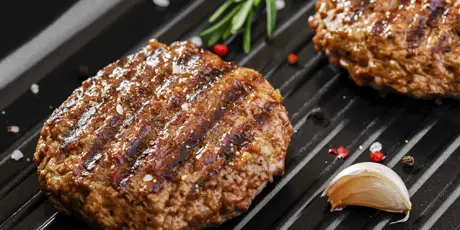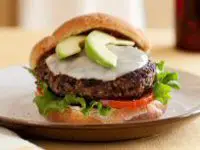We could debate forever about grilled versus griddled burgers. And, while we’re at it, about charcoal versus gas grills. But let’s say you don’t have a grill. Or mabe it’s below-freezing outside. How do you make a great burger without leaving your kitchen?
 First, I need to explain the difference between English-English and American-English. In American-English, grilling is a form of cooking that involves dry heat applied to the surface of food, commonly from above or below. Grilling usually involves a significant amount of direct, radiant heat, and tends to be used for cooking meat and vegetables quickly. Food to be grilled is cooked on a grill, a grill pan, or griddle. Broiling is like grilling, only turned on its head. Broiling is when the heat is applied from above the food. In English-English, grilling is like American broiling. It’s also used for barbeques etcetera when the food rests on a metal grill. The other stuff is ‘pan fried’ or simply ‘fried’. So far; so complicated. So I shall try and explain as I go.
First, I need to explain the difference between English-English and American-English. In American-English, grilling is a form of cooking that involves dry heat applied to the surface of food, commonly from above or below. Grilling usually involves a significant amount of direct, radiant heat, and tends to be used for cooking meat and vegetables quickly. Food to be grilled is cooked on a grill, a grill pan, or griddle. Broiling is like grilling, only turned on its head. Broiling is when the heat is applied from above the food. In English-English, grilling is like American broiling. It’s also used for barbeques etcetera when the food rests on a metal grill. The other stuff is ‘pan fried’ or simply ‘fried’. So far; so complicated. So I shall try and explain as I go.
It seems to me that there are three basic cooking methods you can adopt to cook a burger indoors. The first is to broil your burger under the oven grill (that’s grilling in English-English). The second is to ‘grill’ it in a ridged grill pan (that’s pan-fried in English-English). And the third is on the stove top in a flat-bottomed skillet or frying pan (that’s also pan-fried in English-English).
The good news is that all three methods produce tasty burgers. But there are some tips and tricks that apply to every method. In other words, whether you want to griddle or broil is your call. Just don’t forget to follow these rules for success.
1. Don’t skimp on the fat.
Ground beef (minced beef) is classified according to its fat content. This is important in all ground beef recipes, from meatloaf to meatballs, but especially so when it comes to burgers. My own preference is for a burger with 20 percent fat and 80% meat. That may sound like a lot of fat, but if you’re making burgers, make them right! This fat content yields a juicy, full-flavoured result. Leaner options flirt with blandness and dryness. And a higher fat content risks a greasy burger.
2. Season immediately before cooking.
After you form the burger patty and you are ready to cook it, season the heck out of it with kosher salt (or rock salt) and freshly ground black pepper. But don’t season it before you’re ready to cook. Mixing the ground beef with salt (like you would with meatloaf or meatballs) affects the texture of the meat, making it tougher. By seasoning the outside just before you cook, you get a fabulous, full-flavour, super-tender beef patty.
3. Get the pan (or broiler) crazy hot.
What’s so great about grilling burgers? The smoky char you get from a blazing-hot grill. So by fully heating your pan or broiler, you’re treating your burger to the intense heat it deserves. That’s what creates the crustiest crust, which is as much about textural contrast as it is about big-time flavour. For bonus points, you can heat your pan under the broiler before adding the burger to the pan. That allows you to have a rare burger with a deep rich crust.
 For a burger with a difference, why not try Italian Style Burger? The addition of a little Pecorino Romano to the burger mix and then the melted Provolone cheese on top really does make it feel like Tuscany on a sunny day.
For a burger with a difference, why not try Italian Style Burger? The addition of a little Pecorino Romano to the burger mix and then the melted Provolone cheese on top really does make it feel like Tuscany on a sunny day.